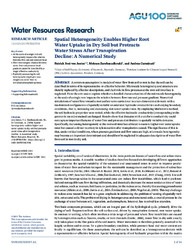Spatial Heterogeneity Enables Higher Root Water Uptake in Dry Soil but Protracts Water Stress After Transpiration Decline: A Numerical Study
von Jeetze, Patrick José
Zarebanadkouki, Mohsen
Carminati, Andrea
DOI: https://doi.org/10.1029/2019WR025501
Persistent URL: http://resolver.sub.uni-goettingen.de/purl?gldocs-11858/8981
Persistent URL: http://resolver.sub.uni-goettingen.de/purl?gldocs-11858/8981
von Jeetze, Patrick José; Zarebanadkouki, Mohsen; Carminati, Andrea, 2020: Spatial Heterogeneity Enables Higher Root Water Uptake in Dry Soil but Protracts Water Stress After Transpiration Decline: A Numerical Study. In: Water Resources Research, Band 56, 1, DOI: 10.1029/2019WR025501.
 |
Dokument öffnen: |
A common assumption in models of water flow from soil to root is that the soil can be described in terms of its representative or effective behavior. Microscale heterogeneity and structure are thereby replaced by effective descriptions, and their role in flow processes at the root-soil interface is neglected. Here the aim was to explore whether a detailed characterization of the microscale heterogeneity at the scale of a single root impacts the relation between flow rate and pressure gradient. Numerical simulations of water flow toward a root surface were carried out in a two-dimensional domain with a randomized configuration of spatially variable unsaturated hydraulic conductivities and varying boundary conditions, that is, increasing and decreasing root water uptake rates. By employing Matheron's method, the soil hydraulic properties were varied, while the effective hydraulic conductivity (corresponding to the geometric mean) remained unchanged. Results show that domains with a uniform conductivity could not capture important features of water flow and pressure distribution in spatially variable domains. Specifically, increasing heterogeneity at the root-soil interface allowed to sustain higher root water uptake rates but caused a slower recovery in xylem suction after transpiration ceased. The significance of this is that, under critical conditions, when pressure gradients and flow rates are high, microscale heterogeneity may become an important determinant and should not be neglected in adequate descriptions of water flow from soil to root in dry soil.
Statistik:
ZugriffsstatistikSammlung:
Schlagworte:
effective soil hydraulic conductivityleaf water potential
soil water potential
root water uptake
root-soil interface
soil heterogeneity
This is an open access article under the terms of the Creative Commons Attribution License, which permits use, distribution and reproduction in any medium, provided the original work is properly cited.

